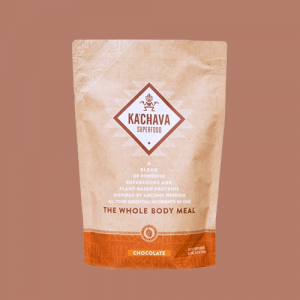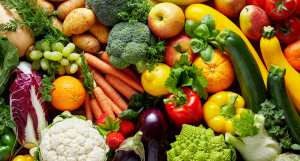KaChava is a plant-based meal replacement shake with over 85 “superfoods”, making this an appealing option for those with busy lifestyles that are seeking a convenient yet health-conscious solution to eating on the go.
With more than 85 ingredients, we have to wonder: Are all of these ingredients backed by science? Are they utilized in effective doses for optimal results? And, of course, is there any inclusion of potentially harmful additives in the formulation?
In this KaChava review, we’ll answer these questions and more to help you decide if this meal replacement shake is right for you.
We’ll also share some KaChava reviews from real customers so you can get their take on the taste and texture of this product, as well as whether or not this nutritional shake causes any unpleasant side effects.

What Are The KaChava Ingredients?
KaChava combines plant-based protein with over 85 ingredients in one formula. After reviewing all of the ingredients in the formula, we’ve distilled the important insights you need, providing a concise overview below:
KaChava Protein
There’s a total of 25 grams (g) of protein in KaChava thanks to a blend of yellow pea protein, brown rice protein, sacha inchi, amaranth, and quinoa.
As you can see, this means that KaChava is suitable for vegans as there are no animal-derived protein ingredients in the formula.
One problem with plant-based proteins is lower bioavailability than animal proteins, such as whey or casein. Nutrient bioavailability is defined as the fraction of a nutrient in a food that is absorbed and utilized.
Research, including a trial published in the journal Nutrients in 2019, has demonstrated that whey protein has a higher bioavailability than pea protein. Ultimately, this means that your body absorbs more of the amino acids (the building blocks of protein) in whey protein than in pea protein.
Despite this, the plant-based protein blend in KaChava could be a good option for vegans, as well as for those with lactose intolerance.
Fiber Blend
The fiber blend inside KaChava consists of organic pure whole grain oat, acacia gum, chia seed, and flax seed. This combination provides a rich source of dietary fiber, thereby promoting digestive health, supporting sustained energy levels, and contributing to a feeling of fullness.
A 2023 publication in the journal Food Science & Nutrition shares that wet chia seeds are sticky due to mucilage and digestible fiber. These are useful in controlling blood sugar after eating, and provide satiety.
Fruits and Vegetables
There’s over a dozen different organic fruits and vegetables included in the KaChava superfood blends, such as acai berry, camu camu berry, tart cherry, beet, carrot, kale, parsley, and more.
While it’s great to have a variety of superfoods in the KaChava shake formula, we have to wonder: how much of each ingredient could be included in these blends?
Probably pretty low amounts. So, if the amounts are low, are these superfoods actually providing benefits? It’s hard to say for sure because the actual amounts of these ingredients are not listed on the ingredient label.
Adaptogens
An adaptogen is a compound that may help the body adapt to stress and promote a sense of balance. The adaptogens in the KaChava shake include maca root, ginger root, and mushrooms like reishi and cordyceps.
Reishi has been shown to exhibit immunomodulatory effects, aiding in immune system regulation and response to stressors. It also influences the stress response by modulating the HPA axis.
Cordyceps can help to increase energy levels and endurance while also supporting adrenal function, enhancing the body’s ability to cope with stressors.
Maca is a root vegetable native to the Andes mountains that’s known for its ability to balance hormones, improve mood, increase energy, and enhance libido.
However, one concern we have is the use of raw maca in KaChava. Raw maca is hard to digest due to the high levels of starch, which could lead to gas, bloating and abdominal discomfort. It’s much better to consume gelatinized maca.
Prebiotic and Probiotic Blend
There’s both pre- and probiotics included in the KaChava shake formula in order to support gut health and digestion.
Probiotics are live beneficial bacteria that support the balance of the gut microbiome, aiding in the digestion and absorption of nutrients. They can contribute to a healthy gut environment, potentially alleviating issues such as bloating, gas, and irregular bowel movements.
Prebiotics, on the other hand, are non-digestible fibers that serve as nourishment for the beneficial bacteria in the gut.
The prebiotic in KaChava is called inulin, a type of fiber.
A 2020 study examined the impact of inulin on gut microbial composition through a review of human studies. In these studies, participants consumed 2g to 20g of inulin daily. The results of the studies revealed a substantial positive effect on the human gut microbiome.
Unfortunately, there’s not much inulin included in the KaChava shake formula. We don’t know the exact amount, but looking at the label we noticed that the “Probiotic / Prebiotic Blend” is only 50 mg total. So the amount of inulin in this formula is nowhere near the 2 – 20 grams of inulin that participants consumed during the study we cited above.
The probiotics in KaChava include Lactobacillus Rhamnosus and Lactobacillus Acidophilus.
Both of these probiotics have substantial research demonstrating their ability to balance the gut microbiome, thereby promoting gut health.
For instance, a 2022 publication in the journal Journal of Microbiology and Biotechnology states, “L. acidophilus has multiple effects on the human body, including nutritional effects, regulation of intestinal flora balance, enhancement of immunity, age-delaying and anti-cancer effects, and support of cholesterol reduction.”
Digestive Enzyme Blend
KaChava contains five digestive enzymes: amylase, protease, cellulase, lactase, and lipase.
The human body already makes these enzymes to help you break down food and absorb nutrients. So why are they included in KaChava?
According to the brand, “They’re naturally produced by the body, but you don’t always make enough — which is why they’re included here.”
From the research we read, digestive enzyme supplementation is mostly helpful for those with digestive disorders and conditions associated with poor digestion including lactose intolerance, according to a publication in the journal Alternative Medicine Review.
Vitamins and Minerals
KaChava includes an extensive list of added vitamins and minerals, such as B-Complex vitamins, iron, vitamin C, phosphorous, magnesium, and many more.
However, keep in mind that Ka’Chava doesn’t provide 100% of your recommended daily intake for any nutrient, so some additional supplementation may be necessary.

What Are The Benefits of KaChava?
With so many superfoods, vitamins, minerals, and other ingredients in KaChava, you may notice the following benefits from this supplement:
Increased Energy
Iron, B-complex vitamins, vitamin D, and other nutrients in Ka’Chava play a critical role in the conversion of food to energy, so you may notice that you have higher energy levels after drinking this shake.
Improved Digestion
Probiotics, digestive enzymes, fiber, and other gut-friendly nutrients in Ka’Chava help regulate digestion and keep your microbiome balanced.
Muscle Growth
Protein, iron, electrolytes, and other nutrients aid in muscle protein synthesis, stamina, hydration, and recovery.
Healthy Weight
There are 240 calories in every 2-scoop serving of KaChava. The brand’s goal is to maximize the calorie-to-satiety ratio in Ka’Chava by optimizing levels of protein (25 g), fiber (9 g), and fats (7 g) — three key nutrients that help control hunger — so you feel full longer without excess calories.
Ultimately, Ka’Chava is satisfying and filling for not a lot of calories!
What Are The Side Effects of KaChava?
While this shake seems to be well-tolerated based on the KaChava reviews we read, it’s possible to experience side effects like gas and bloating due to the xanthan gum and guar gum in the formula.
Another component of KaChava that could lead to gas, bloating, and stomach discomfort is raw maca.
How to Use KaChava?
Just add water and a little ice, then shake or blend until smooth to enjoy.
Where to Buy KaChava?
KaChava is sold on the brand’s website (kachava.com), as well as on Amazon.com.
How Much is KaChava?
KaChava costs $69.95 USD for one bag of 15 servings ($4.66/serving) on the brand’s website.
On Amazon.com, KaChava costs $78.85 for the same amount.
Our Verdict
Overall, we don’t recommend KaChava due to several ingredients with negative side effects and also because we think it’s fairly expensive for what you’re getting.
Pros
- Convenient
- High protein (25 grams per serving)
- Many positive KaChava reviews
- Suitable for vegans
Cons
- Expensive
- Since there are so many different ingredients, there’s likely very low doses of each one
- Plant-derived protein is less bioavailable than animal-derived protein
- Contains flavoring agents
- Contains xanthan gum and guar gum
- Contains raw maca
- Some KaChava reviews mention that it tastes very bad
- Side effects may include stomach pain, gas, bloating
What Are Some Alternatives to KaChava?
If you’re looking for an alternative to KaChava, you may have heard of Huel, another popular meal replacement product. We have our full Huel review here, but ultimately this is another plant-based, high-protein shake.
Due to the better bioavailability, we would recommend a high-quality whey protein meal replacement, such as Designer Whey.
The key to choosing meal replacement products is to look for adequate protein (at least 20 grams of protein) and to watch out for harmful additives like artificial sweeteners, flavorings, and gums/thickeners.
Other beneficial components to look for are fiber (to promote satiety), pre- and probiotics (for gut health), and whole food sources of vitamins and minerals (such as camu camu berry for vitamin C).
References:
Nutrients. 2019 Nov 1;11(11):2613.
Food Sci Nutr. 2023 Jan; 11(1): 3–16.
Eur J Clin Microbiol Infect Dis. 2020 Mar;39(3):403-413.
J Microbiol Biotechnol. 2022 Oct 28; 32(10): 1226–1233.



